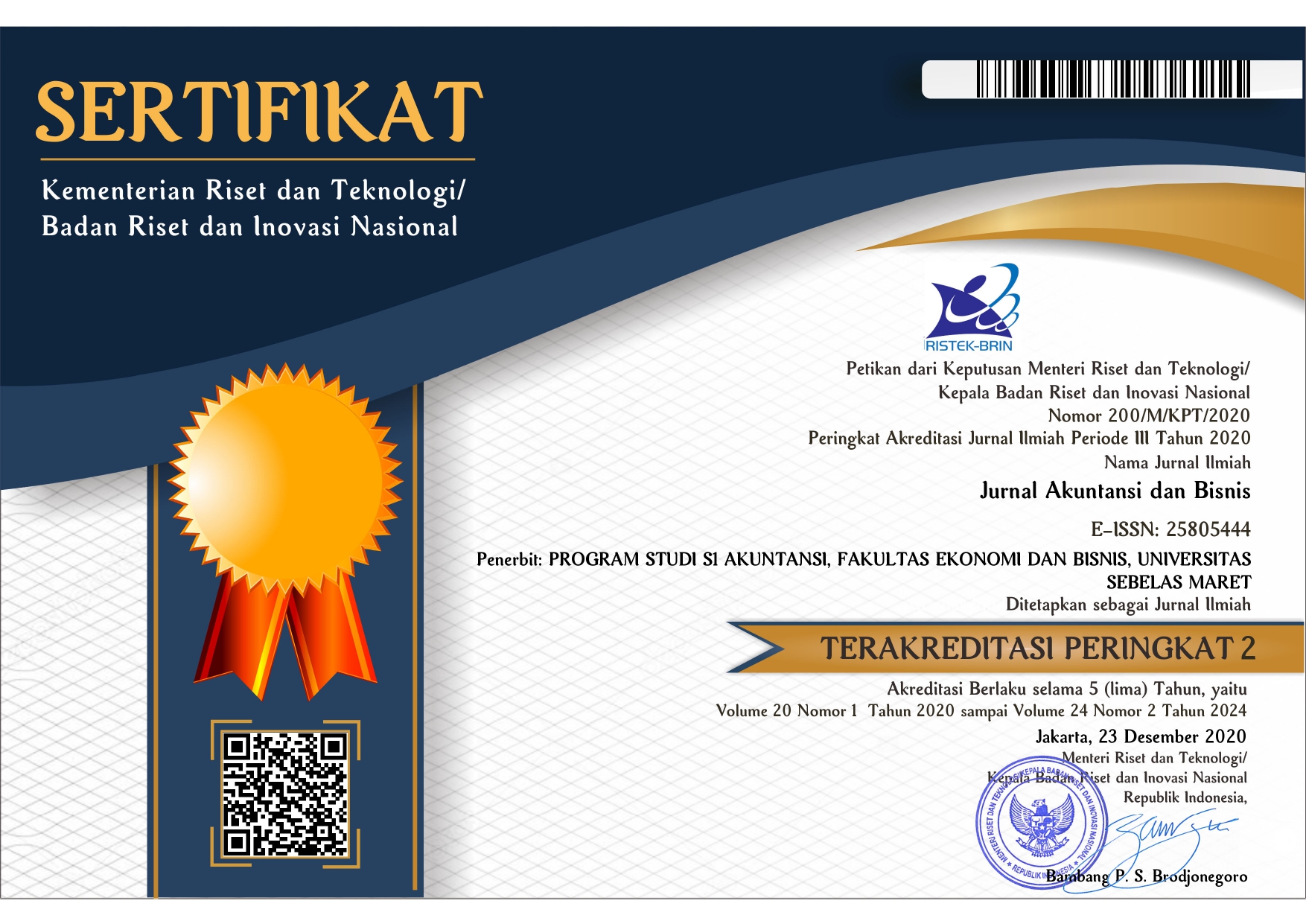Pengungkapan Intellectual Capital : Mandatory atau Voluntary?
Abstract
References
Barney, J. B., Wright, M., and Ketchen, D. J. 2001. The Resource-based View of The Firm: Ten Years After 1991. Journal of Management, 27, 625-641.
Belkaoui, Ahmed-Riahi. 2003. “Intellectual Capital and Firm Performance of US Multinational Firms.” Journal of Intellectual Capital. Vol 4, No. 2, pp. 215-226.
Deegan, C. 2004. Financial Accounting Theory. McGraw-Hill Book Company. Sydney
Erdhianthy, Daissy dan Chaerul D. Djakman. 2014. Pengungkapan Modal Intelektual, Proporsi Komisaris Independen dan Kinerja Bank di Indonesia. Simposium Nasional Akuntansi XVII. Mataram: 24-27 September
Ikatan Akuntan Indonesia. 2009. Pernyataan Standar Akuntansi Keuangan No. 19. Jakarta: Salemba Empat.
Khlifi, F. dan A. Bouri. 2010. Corporate Disclosure and Firm Characteristics: A Puzzling Relationship. Journal of Accounting – Bussiness & Management 17 (1): 62-89.
Leland, H. E., dan D. H. Pyle. 1977. Information Asymetries, Financial Structure, and Financial Intermediation. The Journal of Finance 32 (2): 371-387.
Miller, C. dan H. Whiting. 2005. Voluntary disclosure of intellectual capital anda the “hidden Value”. Proceedings of the accounting and finance association of Australia and new Zealand conference.
Nur, Dhani Ichsanuddin. 2010. Meningkatkan Kinerja Keuangan melalui Intellectual Capital: Bukti Empiris Perusahaan Otomatif Bursa Efek Indonesia. Jurnal Aplikasi Manajemen Vol. 8, No. 3.
Nuswandari, Cahyani. 2009. Pengungkapan Pelaporan Keuangan dalam Perspektif Signalling Theory. Kajian Akuntansi Vol. 1 No. 1 Hal 48-57.
Spanos, Y. E. and Lioukas, S. (2001). An Examina-tion into the Causal Logic of Rent Generation: Contrasting Porter's Competitive Strategy Framework and the Resource-based View Perspective. Strategic Management Journal, 22, 907-934.
Schroeder, R. G., Bates, K. A. and Junttila, M. A. (2002). A Resource-based View of Manufac-turing Strategy and the Relationship to Manufacturing Performance. Strategic Mana-gement Journal, 23, 101-117.
Petty, R. and Guthrie, J. (2000). Intellectual Capi-tal Literature Review: Measurement, Report-ing, and Management. Journal of Intellectual Capital, 1(1), 155-176.
Ray, G., Barney, J. B., and Muhana, W. A. (2004). Capabilities, Business Process, and Competi-tive Advantage: Choosing The Dependent Variable in Empirical Test of The Resource-based View. Strategic Management Journal, 25, 23-37.
Sawarjuwono, Tjiptohadi dan Agustine Prihatin Kadir. 2003. “Intellectual Capital: Perlakuan, Pengukuran dan Pelaporan (Sebuah Library Research).” Jurnal Akuntansi dan Keuangan. Vol 5, No. 1, h.31-51.
Sholikhah, B., A. Rohman dan W. Meiranto. 2010. Implikasi intellectual capital terhadap financial performance, growth, dan market value: studi empiris dengan pendekatan simplistic specification. Simposium Nasional Akuntansi XIII. Purwokerto: 13-14 Oktober.
Soetedjo, Soegeng dan Safrina Mursida. (2014). Pengaruh Intellectual Capital Terhadap Kinerja Keuangan pada Perusahaan Perbankan. Simposium Nasional Akuntansi XVII. Mataram: 24-27 September.
Sugiri, Slamet dan Sumiyana. 2005. Akuntansi Keuangan Menengah Buku I, Edisi Revisian. Yogyakarta: UPP AMP YKPN.
Ulum, Ihyaul. 2008. “Intellectual Capital Performance Sektor Perbankan di Indonesia.” Paper disajikanpada SNA 11, Pontianak.
Widarjo, wahyu. 2011. Pengaruh modal intelektual dan pengungkapan modal intelektual pada nilai perusahaan. Simposiom Nasional Akuntansi XIV. Aceh : 21-22 Juli.
Williams, S.M. 2001. Is Intellectual Capital Performance and Disclosure Practise Related? Journal of Intellectual Capital 2 (3): 192-203.
Wolk, Harry I., James L.Dodd, dan John J. Rozycki. 2008. Accounting Theory, Seventh Edition. USA: Sage Publication, Inc.
DOI: http://dx.doi.org/10.20961/jab.v14i1.151
Jurnal Akuntansi dan Bisnis (JAB)
ISSN 1412-0852 (print), 2580-5444 (online)
Published by Accounting Study Program, Faculty of Economics and Business, Universitas Sebelas Maret, Indonesia

JAB on http://jab.fe.uns.ac.id/index.php/jab is licensed under a Creative Commons Attribution-ShareAlike 4.0 International License










